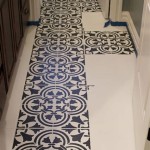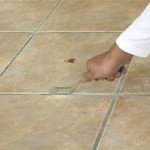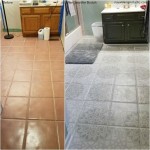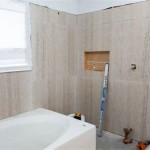Should I Use Cement Board Under Tile? A Comprehensive Guide
The question of whether to use cement board under tile is a common one for both novice DIYers and experienced contractors. The answer, while often leaning towards a resounding yes, involves a nuanced understanding of the substrate’s purpose, the specific tiling project, and the properties of cement board compared to alternative materials. This article will explore the reasons behind recommending cement board for most tile installations, covering its benefits, potential drawbacks, and considerations for specific applications.
The primary function of a substrate beneath tile is to provide a stable, rigid, and moisture-resistant surface for the tile to adhere to. Tile itself is generally waterproof; however, the grout lines are inherently porous. This porosity allows water to penetrate through to the underlying substrate. If the substrate is susceptible to moisture damage or movement, the tile installation is likely to fail over time. This failure can manifest as cracked tiles, loose grout, or even complete detachment of the tile from the surface.
Traditional building materials like plywood or drywall, while suitable for many wall and floor finishes, are not ideal for tile applications in wet or high-humidity environments. Plywood can delaminate when exposed to prolonged moisture, and drywall, even moisture-resistant varieties, can deteriorate and become structurally unsound. Cement board, on the other hand, is specifically designed to withstand these conditions, offering a robust and durable foundation for tile.
Moisture Resistance and Dimensional Stability
Cement board's key advantage lies in its superior moisture resistance. It is composed of cement, reinforced with fibers, which creates a dimensionally stable material that does not rot, warp, or degrade when exposed to water. This property is crucial in areas like bathrooms, showers, kitchens, and laundry rooms, where frequent water exposure is expected. Unlike wood-based products, cement board does not provide a food source for mold or mildew growth, contributing to a healthier indoor environment.
Dimensional stability is another critical factor. Fluctuations in temperature and humidity can cause materials to expand and contract. This movement can stress the tile and grout, eventually leading to cracks and failures. Cement board exhibits minimal expansion and contraction compared to plywood or drywall, ensuring a more stable base for the tile installation. This stability helps to maintain the integrity of the tile surface over time, reducing the likelihood of costly repairs.
To further enhance moisture protection, it's essential to properly seal the seams between cement board sheets and around penetrations like pipes and drains. Using a waterproof membrane in conjunction with cement board provides an added layer of defense against moisture intrusion, especially in wet areas. Several types of membranes are available, including liquid-applied membranes and sheet membranes, each offering varying levels of protection and ease of installation.
Structural Integrity and Load-Bearing Capacity
Beyond moisture resistance, cement board provides excellent structural support for tile installations. Its rigidity and density contribute to a strong and stable substrate, capable of withstanding the weight of the tile and the stresses of foot traffic or other applied loads. This is particularly important for floor installations, where the substrate must be able to support significant weight without deflection.
The thickness of the cement board is a crucial factor in determining its load-bearing capacity. Thicker boards provide greater rigidity and are better suited for applications where heavy tile or stone will be used, or where the floor is subject to high traffic. Common thicknesses for cement board include ¼ inch, ½ inch, and 5/8 inch. The specific thickness required will depend on the framing spacing, the type of tile being installed, and the expected load.
Proper fastening of the cement board to the underlying framing is also essential to ensure its structural integrity. Cement board screws, specifically designed for this purpose, should be used to secure the boards to the studs or joists. The screws should be spaced according to the manufacturer's recommendations to provide adequate support and prevent movement. Pre-drilling pilot holes can help to prevent the cement board from cracking during installation.
Compatibility with Thin-Set Mortar and Tile Adhesion
Cement board is specifically designed to provide an ideal surface for thin-set mortar to bond to. Its textured surface allows the mortar to grip effectively, creating a strong and durable bond between the tile and the substrate. This ensures that the tile remains securely in place, even under demanding conditions.
Unlike some other substrates, cement board does not contain any chemicals or coatings that can interfere with the adhesion of thin-set mortar. This eliminates the need for special primers or surface preparation techniques. However, it is still important to ensure that the cement board is clean and free of dust, debris, or any other contaminants that could compromise the bond.
When selecting thin-set mortar, it's crucial to choose a product that is specifically designed for use with cement board and the type of tile being installed. Different types of thin-set mortar are formulated for different applications, such as large format tile, natural stone, or porcelain tile. Using the appropriate thin-set mortar will ensure optimal adhesion and long-term performance.
Although cement board offers significant advantages, there are specific situations where alternative substrates might be considered. For instance, in dry areas with minimal moisture exposure, properly prepared drywall may be sufficient for wall tile installations. However, it's crucial to carefully assess the risk of moisture intrusion and weigh the potential benefits of cement board against the cost savings of using drywall. In most cases, the added protection and durability of cement board make it the preferred choice for tile installations, especially in wet or high-humidity environments.
Alternatives like some types of backer boards composed of lightweight concrete or foam-based materials, while offering ease of installation and potentially lower weight, may lack the same level of structural rigidity and long-term durability as cement board. The choice depends on the specific project requirements and preferences.
Ultimately, the decision of whether to use cement board under tile involves a careful evaluation of the project's specific needs and the long-term performance requirements. While there may be situations where alternative substrates are acceptable, the superior moisture resistance, structural integrity, and compatibility with thin-set mortar make cement board the most reliable and recommended choice for most tile installations.

How To Install Cement Board On A Floor Diy Family Handyman

Tile Backerboard Material Options Fine Homebuilding

Cement Backerboard Floor Tile Installation Uncookie Cutter

How To Install Hardiebacker Cement Board On Floors James Hardie Pros

Cement Backerboard Floor Tile Installation Uncookie Cutter

How To Install Cement Board The Home Depot

Installing Cement Backerboard For Tile Flooring Hometips

Cement Board Installation On Floors 5 Mistakes To Avoid Diytileguy

Thinset Under Cement Board Yes Or No Ord Ceramic Tile

Tile Installers Select Hardiebacker Cement Board As Most Preferred Brand 2024 02 22 Stone World
Related Posts








